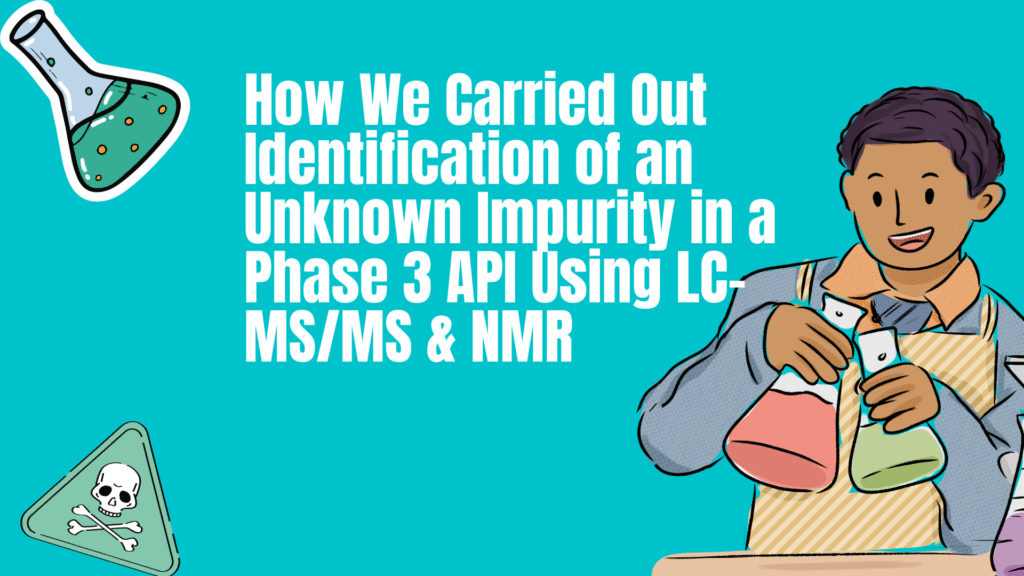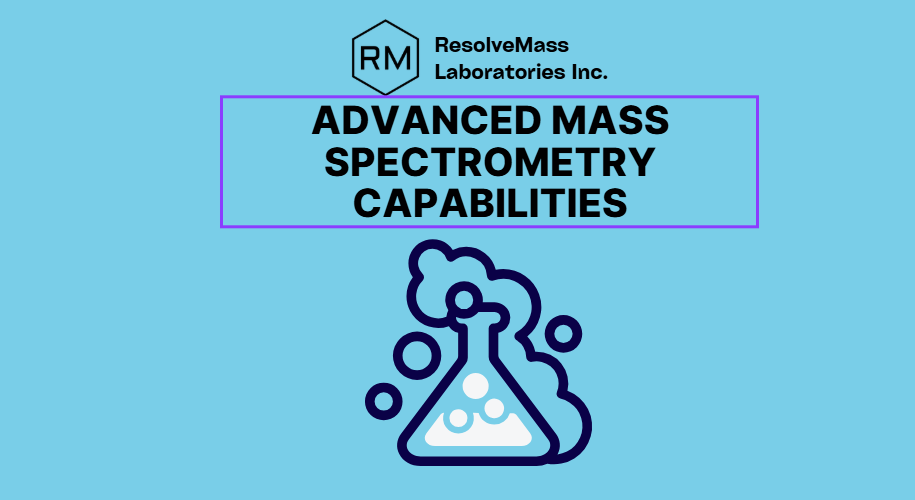
Introduction: Why Identification of an Unknown Impurity is Critical in Phase 3 Drug Development
In late-stage pharmaceutical development, identification of an unknown impurity becomes a top regulatory and quality control priority. A seemingly minor, unidentified impurity in a Phase 3 active pharmaceutical ingredient (API) can derail submission timelines, trigger regulatory concerns, or affect patient safety. At ResolveMass Laboratories Inc., our role as a trusted CRO partner is to provide complete structural elucidation and quantification of such impurities using gold-standard analytical techniques. We have published many research papers on identification and structure elucidation of unknown impurities in pharmaceutical drug substances.
This guide presents a real-world case study on the identification of an unknown impurity in a small-molecule API intended for Phase 3 trials. By combining LC-MS/MS and NMR spectroscopy, ResolveMass successfully resolved the impurity’s identity and origin — allowing the client to proceed with confidence toward NDA submission.
Background – The Importance of Identification of an Unknown Impurity in Phase 3 APIs
Pharmaceutical guidelines (ICH Q3A/B, Q3D) mandate the identification of an unknown impurity when:
- Its concentration exceeds qualification thresholds (e.g., 0.1%).
- Its origin or structure is unknown.
- Its toxicological profile is unassessed.
In this case, the impurity was present at ~0.15% w/w in the final API batch. HPLC-UV could detect the impurity, but not characterize it. This triggered the need for a full impurity profiling investigation.
For detailed impurity profiling support, visit our Impurity Profiling Services.
Step-by-Step Approach for Identification of an Unknown Impurity
At ResolveMass, we follow a scientific and regulatory-compliant methodology for the identification of an unknown impurity, combining:
- Orthogonal separation methods
- High-resolution mass spectrometry (HRMS)
- Nuclear magnetic resonance spectroscopy (NMR)
- In-silico fragmentation and database mapping
1. Isolation of the Unknown Impurity by Semi-Prep HPLC
To begin the identification of an unknown impurity, we first isolated the target impurity using semi-preparative HPLC with photodiode array detection. The fraction was collected at the retention time of 7.2 min and was found to be >95% pure based on analytical re-injection.
2. High-Resolution LC-MS/MS for Molecular Formula Determination
Next, we used our Q Exactive Orbitrap LC-MS/MS system to determine the exact mass and elemental composition:
- Molecular ion [M+H]+ observed at m/z 387.1871
- Mass error: < 2 ppm
- Predicted formula: C21H26N4O3
We then triggered data-dependent MS/MS fragmentation to generate fragment ions, which guided us in mapping substructures.
Explore our MS capabilities on the Impurity Profiling page.
3. Structural Elucidation Using 1D and 2D NMR
With purified material in hand, we used 600 MHz 1H and 13C NMR, along with HSQC and HMBC, to assign proton-carbon correlations. Key observations included:
- An unexpected methylene signal in the aromatic region
- Loss of a methyl group compared to the API standard
- New coupling patterns indicating aromatic substitution
These clues, in combination with MS/MS fragments, helped us complete the identification of the unknown impurity as a hydroxylated derivative of the parent compound formed via minor oxidative degradation.
4. Confirmatory Analysis and Comparison to API
We confirmed our hypothesis by:
- Comparing retention times and MS/MS spectra with a synthetically prepared reference standard
- Running spiking studies and co-injection experiments
- Performing stress testing on the API under oxidative conditions to replicate impurity formation
This comprehensive workflow allowed for unambiguous identification of the unknown impurity.
Key Techniques Used in Identification of an Unknown Impurity
At ResolveMass, our impurity analysis workflows integrate cutting-edge instrumentation for precise identification of unknown impurities:
| Technique | Role in Impurity ID |
|---|---|
| LC-MS/MS (HRMS) | Accurate mass, fragmentation, isotopic analysis |
| NMR (1D/2D) | Structural confirmation via coupling and chemical shifts |
| Semi-Prep HPLC | Impurity isolation |
| In-Silico Tools | Structure matching and toxicity flagging |
Visit Impurity Profiling Services to learn more about these advanced techniques.
Real-World Impact of Identification of an Unknown Impurity
✅ Regulatory Approval Confidence
By carrying out successful identification of an unknown impurity, the client:
- Met ICH Q3A(R2) compliance
- Submitted a defensible impurity profile in their NDA
- Avoided delays in their Phase 3 to approval transition
✅ Manufacturing Process Optimization
Root-cause analysis pointed to a trace-level oxidation pathway during final drying. Our team provided mitigation steps:
- Modified excipient storage
- Controlled drying temperatures
✅ Toxicological Risk Assessment
Our team performed an in-silico DEREK prediction to confirm no genotoxic alerts — eliminating the need for further animal studies.
Why Choose ResolveMass for Identification of an Unknown Impurity
ResolveMass Laboratories Inc. is one of Canada’s leading advanced analytical CROs for impurity profiling and pharmaceutical characterization. Our lab has supported hundreds of NDS, CTA, and ANDA submissions across:
- Small molecules
- Peptides
- Modified oligonucleotides
What sets us apart for identification of an unknown impurity?
✔️ Experience with Regulatory Filings
We design studies aligned with ICH and Health Canada expectations.
✔️ Expert Analytical Scientists
Our team has decades of combined experience in organic chemistry, mass spectrometry, and degradation pathway elucidation.
✔️ End-to-End Support
From impurity isolation to toxicological risk assessment, we offer a complete solution under one roof.
To explore your impurity profiling needs, visit https://resolvemass.ca/impurity-profiling/
Conclusion – The Criticality of Identification of an Unknown Impurity
In regulated drug development, identification of an unknown impurity is more than a technical requirement — it’s a safeguard for patient safety, regulatory compliance, and drug efficacy. ResolveMass Laboratories Inc. offers validated, end-to-end impurity characterization workflows using state-of-the-art LC-MS/MS, NMR, and preparative chromatography.
Our scientific accuracy, regulatory alignment, and commitment to data integrity make us the ideal CRO partner when the stakes are high. If you are facing challenges with unknown impurities in your Phase 1–3 or commercial APIs, let us guide you through confident impurity identification.
📞 Let’s Talk About Your Impurity Challenges
- Contact us for a free consultation.
- Book a technical call with our analytical scientists.
- Request a quote for impurity profiling packages.
ResolveMass Laboratories Inc.: Comprehensive Scientific Expertise You Can Rely On
ResolveMass Laboratories Inc. is a trusted Canadian contract research organization offering a wide spectrum of specialized services spanning polymer synthesis, advanced analytical testing, and custom organic synthesis. With over a decade of experience supporting pharmaceutical, biotech, and industrial clients, we bring scientific precision and regulatory insight to every project. Our core capabilities include Polymer Synthesis and Characterization, Peptide Characterization, Organic Synthesis, Nitrosamine Testing and Analysis, PFAS Testing, and Extractable & Leachable Studies, as well as a broad suite of analytical techniques such as HPLC, GC-MS, MALDI-TOF, NMR, and FTIR.
Our multidisciplinary team includes chemists, analytical scientists, and regulatory experts with advanced academic and industry backgrounds. We excel at developing customized, high-quality solutions—whether you need innovative polymer designs, impurity profiling, or confirmatory testing that meets global regulatory standards.
Clients across North America choose ResolveMass Laboratories for our deep technical knowledge, commitment to quality, and ability to deliver reproducible, reliable data that drives confident decision-making. When precision, innovation, and trust matter—ResolveMass is your partner of choice.
We have PhD level scientist who share this knowledge to you so that you can excel in your impurity identification project. This guide will help you understand all the relevant technical aspects, still if you need more help to understand more in your impurity identification, feel free to book a free consultation with our scientist for your project.
References:
Parmar, R. , Rajput, S. and Mohan, A. (2025) Identification and Structure Elucidation of Novel Forced Degradation Products of Gimeracil. International Journal of Analytical Mass Spectrometry and Chromatography, 13, 1-19. doi: 10.4236/ijamsc.2025.131001.
Parmar R, Rajput S, Mohan A. Identification, isolation, and structure elucidation of novel forced degradation products of nelarabine. Sep Sci plus. 2023; 6:e2200132. https://doi.org/10.1002/sscp.202200132
Parmar R, Rajput S, Mohan A. Identification, isolation and structure elucidation of novel forced degradation products of alectinib hydrochloride. Sep Sci plus. 2021; 4: 174–184. https://doi.org/10.1002/sscp.202000104

